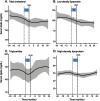APOE polymorphisms influence longitudinal lipid trends preceding intracerebral hemorrhage
- PMID: 27433544
- PMCID: PMC4936477
- DOI: 10.1212/NXG.0000000000000081
APOE polymorphisms influence longitudinal lipid trends preceding intracerebral hemorrhage
Abstract
Objective: We sought to determine whether APOE genotype influences a previously observed decline in serum total cholesterol (TC) and low-density lipoprotein (LDL) levels preceding primary intracerebral hemorrhage (ICH), as a potential demonstration of nonamyloid mechanisms of APOE in ICH risk.
Methods: We performed a single-center retrospective longitudinal analysis using patients with known APOE genotype drawn from an ongoing cohort study of ICH. Serum lipid measurements for TC, triglycerides (TGs), LDL, and high-density lipoprotein (HDL) collected within 2 years before and after index ICH were extracted from electronic medical records. Piecewise linear mixed-effects models were used to compare APOE allele-specific effects on temporal serum lipid trends in ICH. Demographics, medical history, medications, and health maintenance data were included as fixed effects. Inter- and intraindividual variations in lipid levels were modeled as random effects.
Results: A total of 124 ICH cases were analyzed. APOE ε4 carriers had greater rates of decline in serum TC and LDL within 6 months preceding ICH (TC: -7.30 mg/dL/mo, p = 0.0035; LDL: -8.44 mg/dL/mo, p = 0.0001). Conversely, serum TC and LDL levels in APOE ε2 carriers were unchanged within the same time period. APOE genotype had no associations with serum HDL or TG trends.
Conclusions: APOE allele status predicts serum TC and LDL changes preceding acute ICH. Our results have implications for ongoing efforts in dissecting the role of dyslipidemia in cerebrovascular disease risk. APOE genotype-specific influence on lipid trends provides a clue for one mechanism by which APOE may influence risk of ICH. Further characterization of the metabolic roles of APOE is needed to improve the understanding of APOE biology in cerebrovascular disease risk.
Figures



References
-
- Krishnamurthi RV, Moran AE, Forouzanfar MH, et al. The global burden of hemorrhagic stroke: a summary of findings from the GBD 2010 study. Glob Heart 2014;9:101–106. - PubMed
-
- Poon MT, Fonville AF, Al-Shahi Salman R. Long-term prognosis after intracerebral haemorrhage: systematic review and meta-analysis. J Neurol Neurosurg Psychiatry 2014;85:660–667. - PubMed
-
- van Asch CJ, Luitse MJ, Rinkel GJ, van der Tweel I, Algra A, Klijn CJ. Incidence, case fatality, and functional outcome of intracerebral haemorrhage over time, according to age, sex, and ethnic origin: a systematic review and meta-analysis. Lancet Neurol 2010;9:167–176. - PubMed
Grants and funding
LinkOut - more resources
Full Text Sources
Other Literature Sources
Miscellaneous
